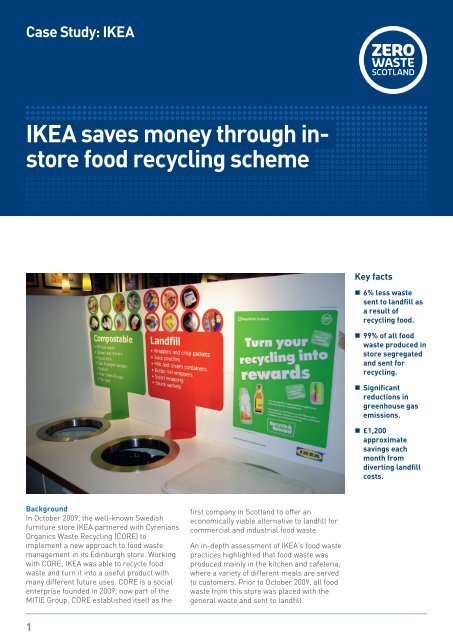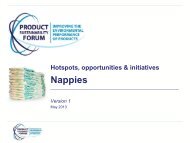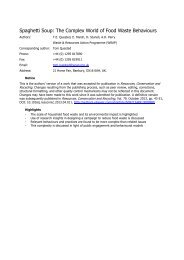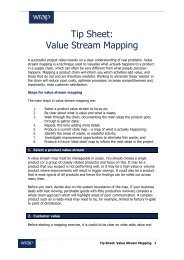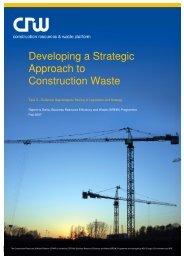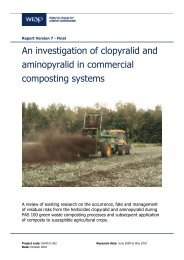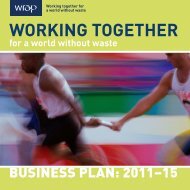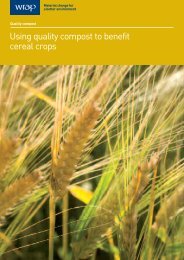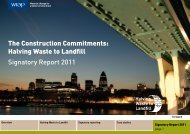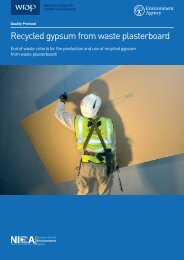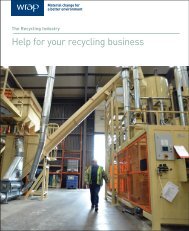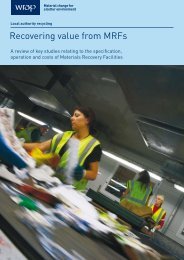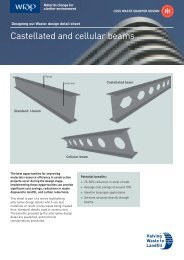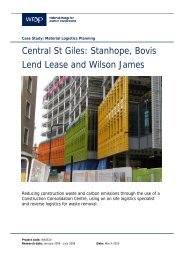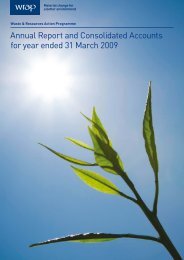IKEA saves money through in- store food recycling scheme - Wrap
IKEA saves money through in- store food recycling scheme - Wrap
IKEA saves money through in- store food recycling scheme - Wrap
You also want an ePaper? Increase the reach of your titles
YUMPU automatically turns print PDFs into web optimized ePapers that Google loves.
Case Study: <strong>IKEA</strong><br />
<strong>IKEA</strong> <strong>saves</strong> <strong>money</strong> <strong>through</strong> <strong>in</strong><strong>store</strong><br />
<strong>food</strong> recycl<strong>in</strong>g <strong>scheme</strong><br />
Background<br />
In October 2009, the well-known Swedish<br />
furniture <strong>store</strong> <strong>IKEA</strong> partnered with Cyrenians<br />
Organics Waste Recycl<strong>in</strong>g (CORE) to<br />
implement a new approach to <strong>food</strong> waste<br />
management <strong>in</strong> its Ed<strong>in</strong>burgh <strong>store</strong>. Work<strong>in</strong>g<br />
with CORE, <strong>IKEA</strong> was able to recycle <strong>food</strong><br />
waste and turn it <strong>in</strong>to a useful product with<br />
many different future uses. CORE is a social<br />
enterprise founded <strong>in</strong> 2009, now part of the<br />
MITIE Group. CORE established itself as the<br />
1<br />
first company <strong>in</strong> Scotland to offer an<br />
economically viable alternative to landfill for<br />
commercial and <strong>in</strong>dustrial <strong>food</strong> waste.<br />
An <strong>in</strong>-depth assessment of <strong>IKEA</strong>’s <strong>food</strong> waste<br />
practices highlighted that <strong>food</strong> waste was<br />
produced ma<strong>in</strong>ly <strong>in</strong> the kitchen and cafeteria,<br />
where a variety of different meals are served<br />
to customers. Prior to October 2009, all <strong>food</strong><br />
waste from this <strong>store</strong> was placed with the<br />
general waste and sent to landfill.<br />
Key facts<br />
6% less waste<br />
sent to landfill as<br />
a result of<br />
recycl<strong>in</strong>g <strong>food</strong>.<br />
99% of all <strong>food</strong><br />
waste produced <strong>in</strong><br />
<strong>store</strong> segregated<br />
and sent for<br />
recycl<strong>in</strong>g.<br />
Significant<br />
reductions <strong>in</strong><br />
greenhouse gas<br />
emissions.<br />
£1,200<br />
approximate<br />
sav<strong>in</strong>gs each<br />
month from<br />
divert<strong>in</strong>g landfill<br />
costs.
Case Study<br />
<strong>IKEA</strong> <strong>saves</strong> <strong>money</strong> <strong>through</strong> <strong>in</strong>-<strong>store</strong> <strong>food</strong> recycl<strong>in</strong>g <strong>scheme</strong><br />
How was the <strong>food</strong> recycl<strong>in</strong>g <strong>scheme</strong><br />
implemented?<br />
Food recycl<strong>in</strong>g was <strong>in</strong>troduced to the <strong>IKEA</strong><br />
<strong>store</strong> <strong>in</strong> Ed<strong>in</strong>burgh us<strong>in</strong>g a two-phase<br />
approach and by creat<strong>in</strong>g a key partnership<br />
with CORE. Start<strong>in</strong>g <strong>in</strong> October 2009, <strong>IKEA</strong><br />
successfully <strong>in</strong>troduced the segregation of all<br />
<strong>food</strong> waste produced dur<strong>in</strong>g the on-site <strong>food</strong><br />
preparation process. This waste is now sent<br />
for treatment <strong>in</strong> the local anaerobic digestion<br />
plant, where it is processed to make fertiliser<br />
and energy.<br />
In June 2011, phase two of the <strong>food</strong> recycl<strong>in</strong>g<br />
project started. This was targeted at tackl<strong>in</strong>g<br />
the <strong>food</strong> waste produced <strong>in</strong> the cafeteria,<br />
which was ma<strong>in</strong>ly composed of consumer<br />
leftovers.<br />
This phase <strong>in</strong>volved <strong>IKEA</strong> doubl<strong>in</strong>g the size of<br />
the cafeteria area and implement<strong>in</strong>g a highly<br />
efficient segregation <strong>scheme</strong> <strong>in</strong> the public<br />
areas. A central recycl<strong>in</strong>g hub was built <strong>in</strong> the<br />
cafeteria, with a three-b<strong>in</strong> system for <strong>food</strong><br />
waste, general waste and recycl<strong>in</strong>g. The hub<br />
is user friendly and clearly expla<strong>in</strong>s to<br />
customers where to place their waste, what<br />
can be recycled and what goes to landfill.<br />
Staff engagement was also seen to have an<br />
important role, so detailed practical tra<strong>in</strong><strong>in</strong>g<br />
sessions on recycl<strong>in</strong>g were delivered to all of<br />
the <strong>store</strong>’s cafeteria staff. The result of this<br />
tra<strong>in</strong><strong>in</strong>g was a 98% engagement rate from<br />
staff with<strong>in</strong> the first week.<br />
The results<br />
Before October 2009, no <strong>food</strong> waste was<br />
recycled at <strong>IKEA</strong>’s Ed<strong>in</strong>burgh <strong>store</strong>. Between<br />
October 2009 and May 2011, CORE collected<br />
an average of 2.1 tonnes each month from the<br />
Zero Waste Scotland<br />
Ground Floor, Moray House, Forthside Way,<br />
Stirl<strong>in</strong>g, FK8 1QZ.<br />
E-mail: helpl<strong>in</strong>e@zerowastescotland.org.uk<br />
Helpl<strong>in</strong>e freephone 0808 100 2040<br />
www.zerowastescotland.org.uk<br />
kitchen. Phase two started <strong>in</strong> June 2011 and<br />
<strong>in</strong> the six-month period between July and<br />
December 2011 the average collection was 6.5<br />
tonnes each month.<br />
As a result of staff tra<strong>in</strong><strong>in</strong>g and clear signage<br />
that engaged customers, less than 3% of the<br />
<strong>food</strong> waste collected had other materials <strong>in</strong> it;<br />
significantly better than the national average.<br />
N<strong>in</strong>ety-n<strong>in</strong>e per cent of the <strong>food</strong> waste<br />
collected by CORE was then processed at the<br />
local anaerobic digestion plant and used to<br />
produce both a nutrient-rich fertiliser for use<br />
by farmers and a methane-rich biogas that<br />
can be used to generate electricity to be fed<br />
back <strong>in</strong>to the National Grid.<br />
Benefits<br />
Food recycl<strong>in</strong>g represents a closed-loop<br />
process, as the waste is turned <strong>in</strong>to a material<br />
that is resold as a fertiliser/soil conditioner<br />
and used by farmers to grow more <strong>food</strong>. Food<br />
recycl<strong>in</strong>g has clear benefits for bus<strong>in</strong>esses, as<br />
well as a positive impact on the economy and<br />
the environment. Recycl<strong>in</strong>g <strong>food</strong> enables<br />
bus<strong>in</strong>esses not only to be compliant with the<br />
new Waste (Scotland) Regulations, but also to<br />
make f<strong>in</strong>ancial sav<strong>in</strong>gs and promote corporate<br />
responsibility, which can, <strong>in</strong> turn, lead to<br />
additional benefits such as an improved<br />
customer base.<br />
Implement<strong>in</strong>g this <strong>food</strong> waste recycl<strong>in</strong>g<br />
process has had significant f<strong>in</strong>ancial and<br />
environmental benefits. The <strong>store</strong> has<br />
significantly reduced its greenhouse gas<br />
emissions, sav<strong>in</strong>g 15.2 tonnes of carbon<br />
dioxide and 6.8 tonnes of methane each<br />
month, and creat<strong>in</strong>g monthly f<strong>in</strong>ancial sav<strong>in</strong>gs<br />
of £1,200.<br />
While steps have been taken to ensure its accuracy, Zero Waste Scotland cannot accept responsibility or be held liable to any person for loss or damage aris<strong>in</strong>g out of or <strong>in</strong> connection with this<br />
<strong>in</strong>formation be<strong>in</strong>g <strong>in</strong>accurate, <strong>in</strong>complete or mislead<strong>in</strong>g. This material is copyrighted. It may be reproduced free of charge subject to the material be<strong>in</strong>g accurate and not used <strong>in</strong> a mislead<strong>in</strong>g context.<br />
The source of the material must be identified and the copyright status acknowledged. This material must not be used to endorse or used to suggest Zero Waste Scotland’s endorsement of<br />
a commercial product or service. For more detail, please refer to our Terms & Conditions on our website: www.zerowastescotland.org.uk/terms


